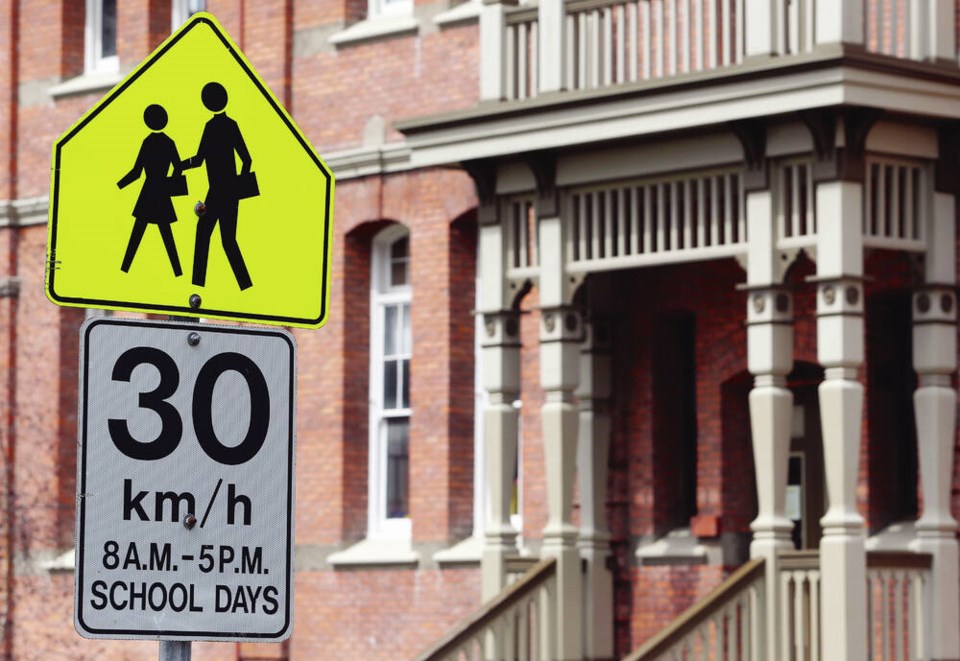Summer is always over way too soon for me. Putting wildfires and heat domes aside for just one moment, I love long, lazy summer days and those warm evenings that accompany them.
All good things come to an end, though, and next week summer is unofficially over with thousands of kids returning to school. So, it’s time we refocus on driving safely around school and playground zones.
According to Canadian Automobile Association surveys, nearly one-quarter of drivers have witnessed either a collision or a near miss involving a child in or near a school zone. Given the amount of traffic passing through some of our school zones, that’s a worry.
Nearly half of the drivers surveyed witnessed an incident of distracted driving in a school zone. Last year, I recall three incidents myself where cars were way over the 30 km/h limit. One driver was also on a cellphone, but more disturbingly, the other two times where cars sped past, they pulled into the teachers’ parking lot.
That jibes with CAA surveys which show that 70% of us have witnessed cars speeding through school zones, with another 60% of us feeling that driving practices in school zones are worse than they were in the past.
According to ICBC, 66 children are injured every year in ÎÚÑ»´«Ã½ in school and playground zones. Statistically that’s a small number compared to all the students in our school system. But any child death or injury strikes a particular knell in the hearts of a community, with deep emotional impacts which can last for years.
Last year, the cops handed out 6,500 tickets in ÎÚÑ»´«Ã½ for school and playground zone violations - yet the concerns remain.
So beyond enforcement what can be done?
Put time on your side. Every family has time crunches. It’s just part of life with kids but a little proactive organization can help around getting them to school on time.
The CAA recommends things like a “launching pad”, where all school supplies, lunches etc. are put in place in the same spot, near the door, the night before each school day. Saving 10 minutes to get out the door lessens the need to drive faster to get everyone to school on time.
Be aware of changes in your route, such as construction delays. Roadway infrastructure improvement is big right now and I often ran into several road delays around schools last season.
Teach kids road awareness everyday. It takes kids quite awhile to learn that cars, especially speeding ones, can appear from nowhere. Wherever possible cross at crosswalks and develop that “head on a swivel” mentality for kids walking along the street.
Crosswalks are important but they are not force fields. I’ve lost count of the number of times I’ve witnessed an adult step out into crosswalks without even turning their heads — many times with kids in tow. Ensure kids know about making eye contact with drivers and wait until an approaching vehicle actually stops.
Once outside the school fence, the fooling around should stop. Tag and hide and seek are for the playground not for busy roadways. Kids should stay on the inside edge of the sidewalk, away from traffic.
If kids are driven to school, door opening awareness is important. Children should not exit vehicles on the street side.
Teach road awareness from day one and don’t allow more distractions like wearing headphones and earbuds while walking to school. Children are curious and distracted at the best of times — electronic devices only compound the problem.
As a driver, the two biggest issues affecting safety within school zones are speeding and distraction. Be aware of those problems in advance and make driving your total priority, at all times, but especially when entering school and playground zones.
Glove Box: Kirby asked last week about joggers running out in front of cars at an unmarked crosswalk. Pedestrian versus vehicle rules are unfortunately complicated. There’s at least 4 or 5 sections alone in our motor vehicle act covering it all.
Every intersection has crosswalks. Problem is that not all of them are marked with lines, but the same rules still apply as if those lines were there.
Drivers must yield to persons in crosswalks, but pedestrians shall not enter roadways when it is impractical for a driver to stop.
If pedestrians cross a highway where there is no crosswalk, they must yield to vehicles.
Drivers, however, must always exercise due care to avoid colliding with a pedestrian who is on the highway, give warning via horn if necessary and observe extra care with children or confused persons who might be present.
Easy to see why some police investigations around pedestrians who are struck by vehicles can take months or even years to figure out.
>>> To comment on this article, write a letter to the editor: [email protected]



